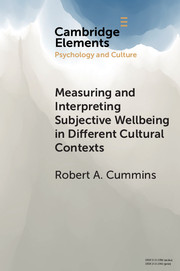Element contents
Measuring and Interpreting Subjective Wellbeing in Different Cultural Contexts
Published online by Cambridge University Press: 24 May 2018
Summary
- Type
- Element
- Information
- Online ISBN: 9781108685580Publisher: Cambridge University PressPrint publication: 17 May 2018
References
- 30
- Cited by

